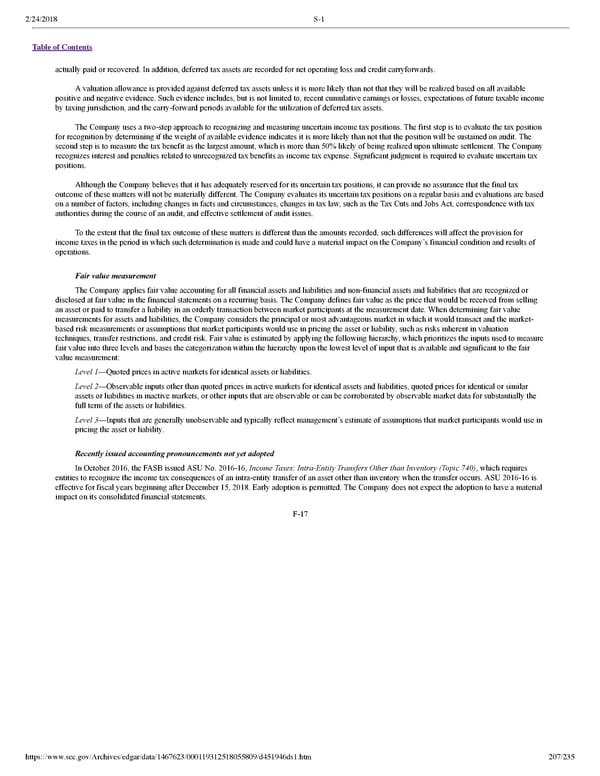2/24/2018 S-1 Table of Contents actually paid or recovered. In addition, deferred tax assets are recorded for net operating loss and credit carryforwards. A valuation allowance is provided against deferred tax assets unless it is more likely than not that they will be realized based on all available positive and negative evidence. Such evidence includes, but is not limited to, recent cumulative earnings or losses, expectations of future taxable income by taxing jurisdiction, and the carryforward periods available for the utilization of deferred tax assets. The Company uses a twostep approach to recognizing and measuring uncertain income tax positions. The first step is to evaluate the tax position for recognition by determining if the weight of available evidence indicates it is more likely than not that the position will be sustained on audit. The second step is to measure the tax benefit as the largest amount, which is more than 50% likely of being realized upon ultimate settlement. The Company recognizes interest and penalties related to unrecognized tax benefits as income tax expense. Significant judgment is required to evaluate uncertain tax positions. Although the Company believes that it has adequately reserved for its uncertain tax positions, it can provide no assurance that the final tax outcome of these matters will not be materially different. The Company evaluates its uncertain tax positions on a regular basis and evaluations are based on a number of factors, including changes in facts and circumstances, changes in tax law, such as the Tax Cuts and Jobs Act, correspondence with tax authorities during the course of an audit, and effective settlement of audit issues. To the extent that the final tax outcome of these matters is different than the amounts recorded, such differences will affect the provision for income taxes in the period in which such determination is made and could have a material impact on the Company’s financial condition and results of operations. Fair value measurement The Company applies fair value accounting for all financial assets and liabilities and nonfinancial assets and liabilities that are recognized or disclosed at fair value in the financial statements on a recurring basis. The Company defines fair value as the price that would be received from selling an asset or paid to transfer a liability in an orderly transaction between market participants at the measurement date. When determining fair value measurements for assets and liabilities, the Company considers the principal or most advantageous market in which it would transact and the market based risk measurements or assumptions that market participants would use in pricing the asset or liability, such as risks inherent in valuation techniques, transfer restrictions, and credit risk. Fair value is estimated by applying the following hierarchy, which prioritizes the inputs used to measure fair value into three levels and bases the categorization within the hierarchy upon the lowest level of input that is available and significant to the fair value measurement: Level 1—Quoted prices in active markets for identical assets or liabilities. Level 2—Observable inputs other than quoted prices in active markets for identical assets and liabilities, quoted prices for identical or similar assets or liabilities in inactive markets, or other inputs that are observable or can be corroborated by observable market data for substantially the full term of the assets or liabilities. Level 3—Inputs that are generally unobservable and typically reflect management’s estimate of assumptions that market participants would use in pricing the asset or liability. Recently issued accounting pronouncements not yet adopted In October 2016, the FASB issued ASU No. 201616, Income Taxes: IntraEntity Transfers Other than Inventory (Topic 740), which requires entities to recognize the income tax consequences of an intraentity transfer of an asset other than inventory when the transfer occurs. ASU 201616 is effective for fiscal years beginning after December 15, 2018. Early adoption is permitted. The Company does not expect the adoption to have a material impact on its consolidated financial statements. F17 https://www.sec.gov/Archives/edgar/data/1467623/000119312518055809/d451946ds1.htm 207/235
 Dropbox S-1 | Interactive Prospectus Page 206 Page 208
Dropbox S-1 | Interactive Prospectus Page 206 Page 208